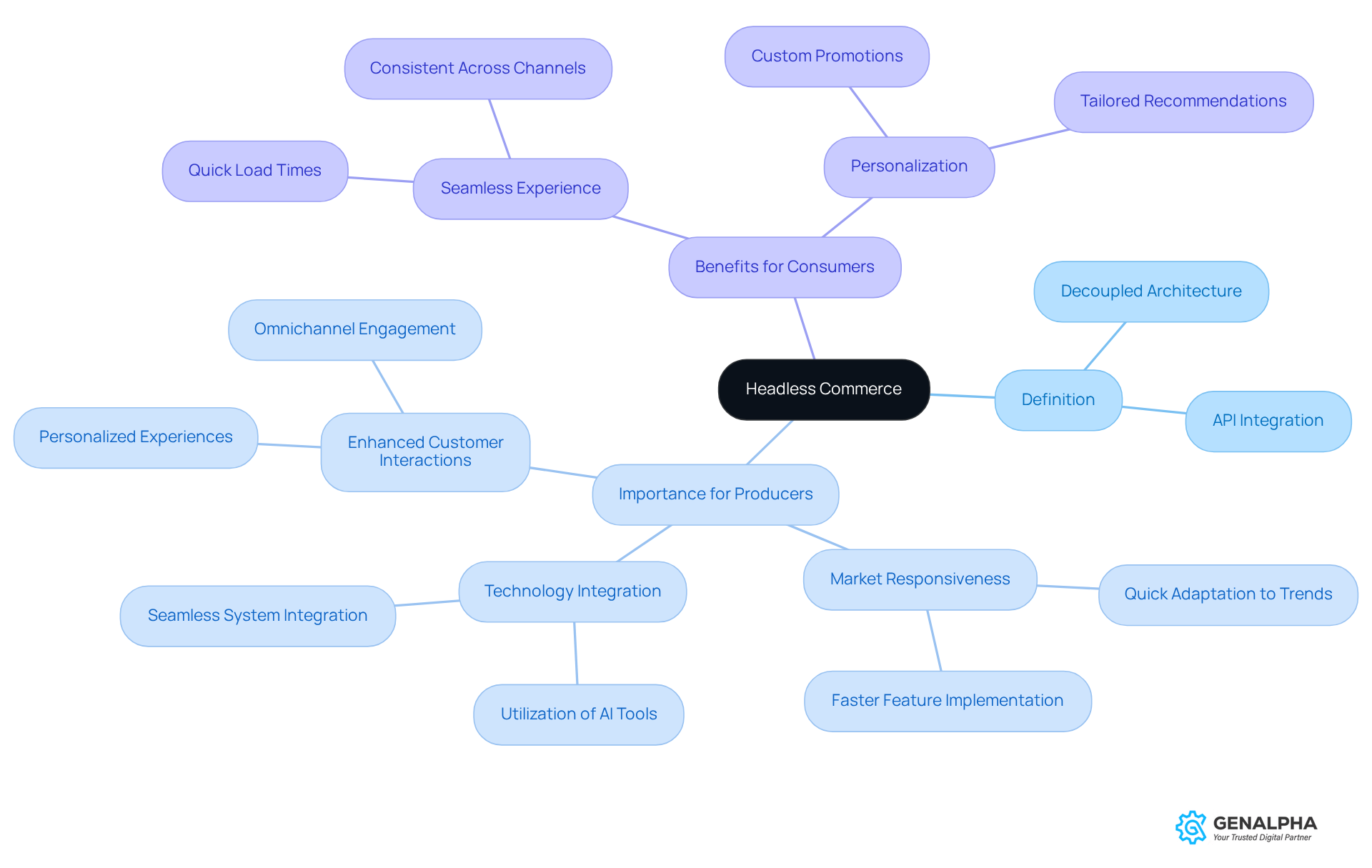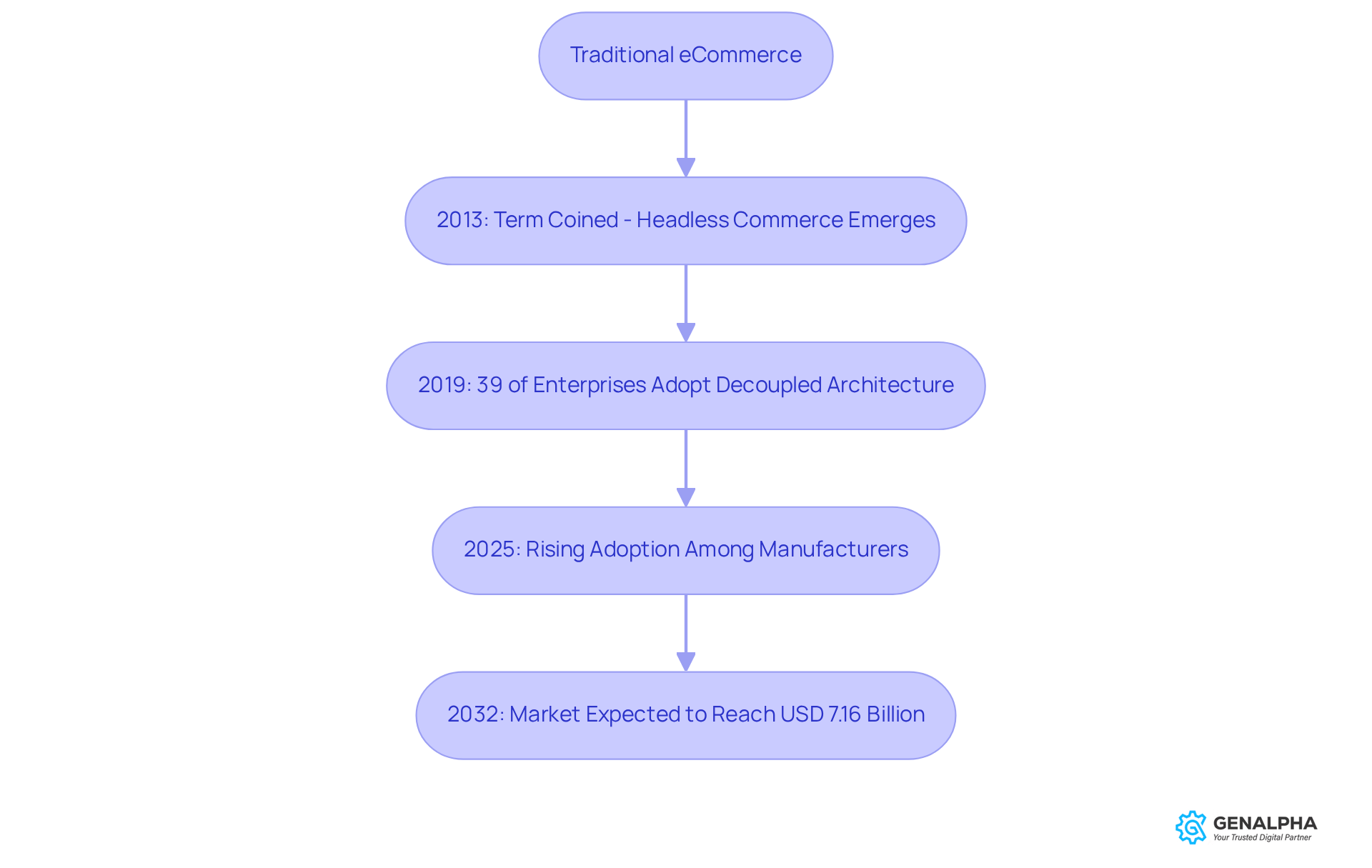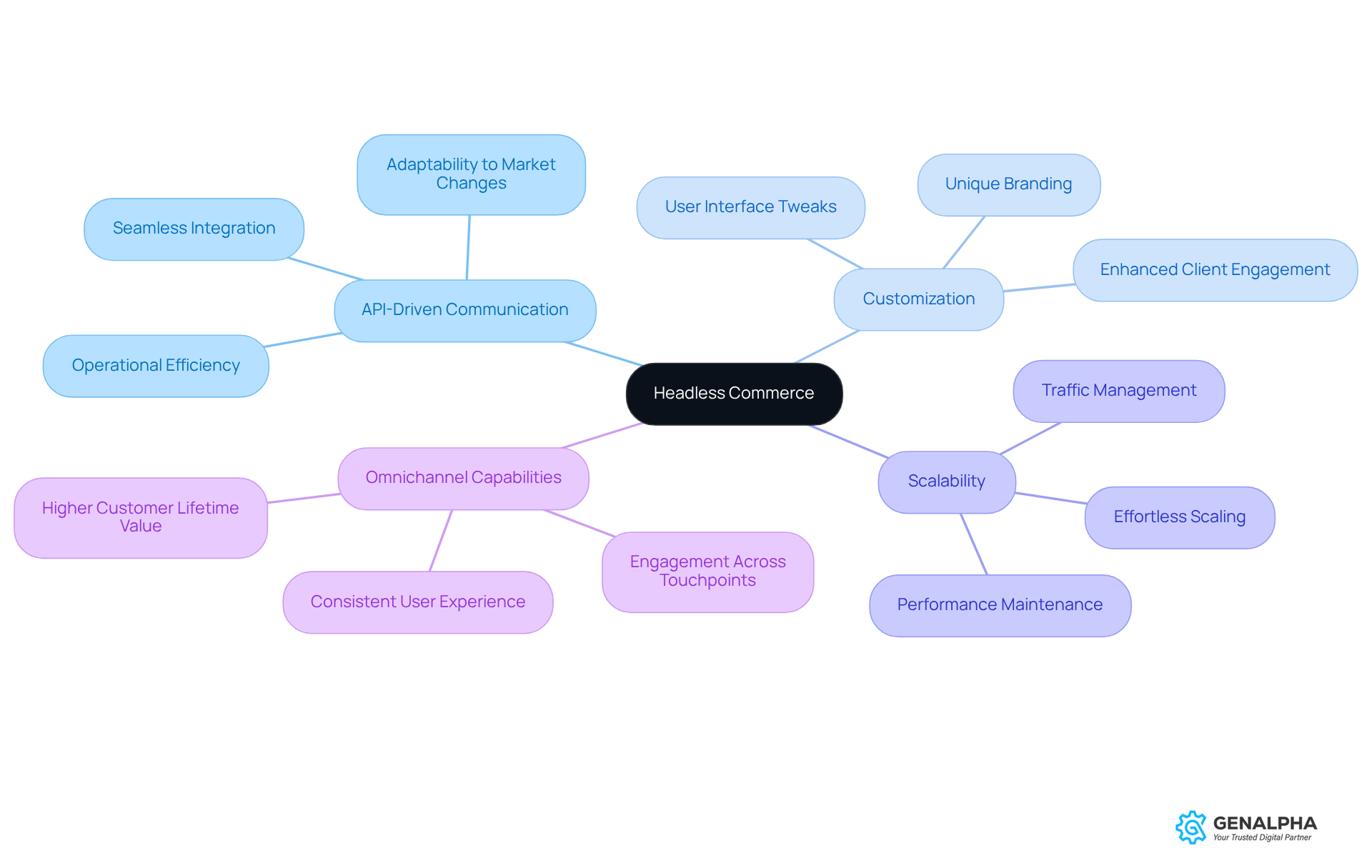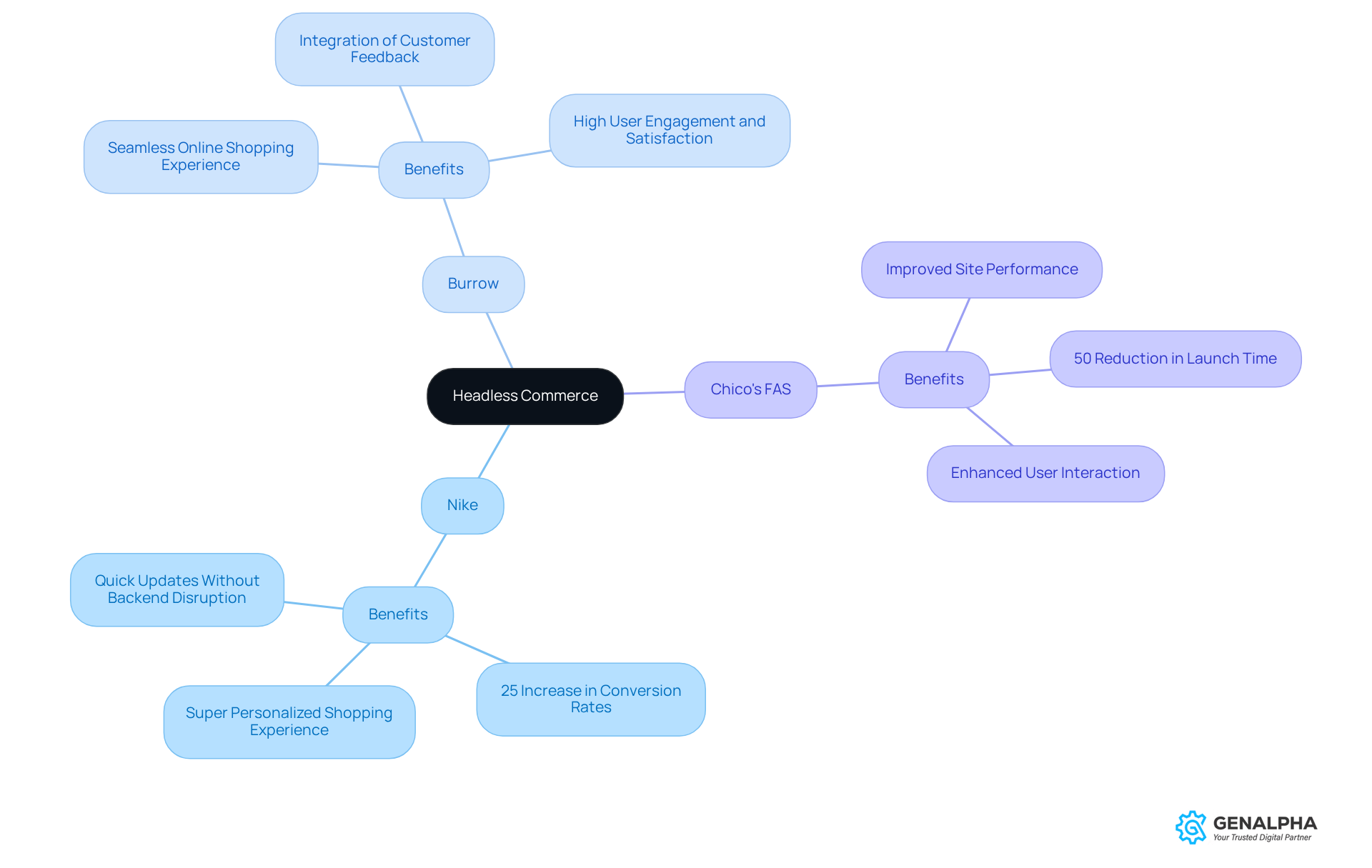Overview
Have you ever wondered what headless commerce really means? Well, it’s more than just a buzzword; it’s a game changer for manufacturers! By decoupling front-end and back-end operations, headless commerce boosts flexibility and enhances customer experience. This isn’t just theory—look at companies like Nike and Burrow. They’ve embraced headless architectures and seen fantastic results, including:
- Better personalization
- Higher conversion rates
- Quicker time-to-market
It’s clear that this approach is transforming the eCommerce landscape today. So, how can you leverage headless commerce in your own business?
Introduction
The landscape of eCommerce is experiencing a major transformation, with manufacturers increasingly embracing headless commerce to reshape their online shopping experiences. This fresh approach separates the front-end interface from back-end operations, providing unmatched customization and flexibility that traditional platforms just can't offer. As consumers crave more personalized and seamless interactions, you might wonder: how can manufacturers tap into headless commerce to not only meet these expectations but truly exceed them, all while tackling the challenges of implementation?
Defining Headless Commerce: Concept and Importance
Have you ever thought about how eCommerce is evolving? Well, the signifies a game-changer in this space. Imagine an online shopping experience where the part you see—the front-end display—is completely separate from the behind-the-scenes functionality where all the business magic happens. This separation allows companies to craft shopping environments that reflect the headless commerce meaning, being both customizable and adaptable, thus breaking free from the limitations of traditional eCommerce platforms.
For producers, jumping on the decoupled sales train is crucial. Why? Because it empowers them to respond swiftly to market changes, integrate new technologies, and enhance customer interactions across multiple channels. The beauty of headless transactions lies in their ability to create a seamless and personalized shopping experience, highlighting the headless commerce meaning that today’s consumers are really craving.
So, the next time you’re browsing online, think about the innovative structures that make your shopping experience not just easy, but enjoyable. Isn’t it exciting to see how technology is reshaping the way we shop?

The Evolution of Headless Commerce: Historical Context and Trends
The emerging headless commerce meaning has been recognized as a smart solution to the issues we often see with traditional eCommerce platforms. You know, those systems that bundle everything together into one rigid package? Yeah, that monolithic structure can really limit flexibility and stifle innovation. The term 'headless trade' was coined around 2013, marking a significant shift toward modular architectures that focus on agility and customization. As producers and sellers realized the need for more flexible solutions, decoupled retail systems started to gain traction, becoming essential for boosting digital presence and meeting the ever-changing expectations of consumers.
Looking ahead to 2025, trends indicate a noticeable rise in unbundled retail adoption among manufacturers. This is largely driven by the increasing demand for personalized and seamless customer experiences. In fact, a whopping 64% of enterprises are already using decoupled architecture, which is a 25% jump since 2019! Plus, the global decoupled retail market is expected to soar to USD 7.16 billion by 2032, thanks to the push for omnichannel retail strategies.
Experts in the field are quick to point out that headless commerce meaning is not just a passing trend; it’s a practical, scalable solution to modern business challenges. For instance, a study revealed that 92% of companies find it easier to create engaging digital interactions when using decoupled platforms. This setup illustrates headless commerce meaning by allowing manufacturers to separate their front-end presentation from back-end operations, enabling them to craft without the constraints of traditional templates.
But let’s be real—there are hurdles to overcome. High initial implementation costs and the complexities of integrating new solutions with existing systems can be significant barriers to adoption. However, the impact of non-traditional commerce, often described as headless commerce meaning, on manufacturers is substantial. It speeds up go-to-market timelines and boosts operational efficiency. Look at companies like Nike and Toyota; they’ve successfully transitioned to decoupled setups, leading to enhanced personalization and customer engagement. For example, Toyota’s use of a decoupled architecture has improved their interactive engagements through real-time content integration.
As the landscape continues to evolve, producers who embrace a decoupled sales approach will be in a better position to adapt to market shifts and meet the demands of an active consumer base. Plus, the potential for headless systems to support IoT shopping experiences really highlights its importance in the future of online retail. So, are you ready to explore how these changes can benefit your business?

Key Characteristics of Headless Commerce: Architecture and Functionality
The concept of headless commerce meaning is centered on its decoupled architecture, enabling us to develop and manage front-end and back-end systems independently. This setup brings several cool features to the table:
- API-Driven Communication: APIs make it super easy to exchange data between the front-end and back-end, allowing for seamless integration with third-party services. This not only boosts operational efficiency but also helps manufacturers adapt quickly to market changes. Let’s face it, the flexibility of API-driven commerce is vital for brands looking to innovate and personalize their interactions with clients.
- Customization: Manufacturers can tweak the user interface to fit specific client needs without messing with back-end processes. This ability encourages unique branding and user experiences, which are essential in today’s competitive landscape where personalization is the name of the game. Trends in customization show that brands are leaning towards more personalized solutions, which ultimately enhances client engagement and satisfaction.
- Scalability: Headless commerce meaning includes systems designed to scale effortlessly, effectively managing increased traffic and transactions. This scalability is a game-changer for manufacturers experiencing growth, as it allows them to respond to demand fluctuations without sacrificing performance.
- Omnichannel Capabilities: The architecture supports multiple sales channels, ensuring a consistent experience whether you're shopping online, in-store, or on mobile. Did you know that omnichannel buyers have a 30% greater lifetime value compared to those who stick to just one channel? That’s a big deal for manufacturers looking to engage customers at different touchpoints, ultimately boosting sales and loyalty.
These features empower manufacturers to create dynamic and responsive eCommerce solutions that enhance client satisfaction and drive sales, which illustrates the headless commerce meaning in positioning them effectively in the digital marketplace. However, embracing a decoupled approach does come with its challenges, like needing skilled developers and navigating the complexities of separating systems. For instance, Allbirds has successfully utilized a decoupled sales approach with Shopify’s Hydrogen and Oxygen framework, showing how producers can leverage this structure for better customer interaction and loyalty. Plus, it’s crucial to remember that a 1-second lag in mobile page loading can cut conversions by as much as 20%. That really highlights the importance of speed and efficiency in modern retail. What do you think about ?

Real-World Applications: Examples of Headless Commerce in Action
Many companies across various sectors have jumped on the bandwagon of headless commerce meaning to boost their operations. Take a look at a few examples:
- Nike: By adopting a headless architecture, Nike has created a super personalized shopping experience across its digital platforms. This flexibility means they can roll out updates and new features quickly without messing with back-end operations, which significantly boosts customer satisfaction. Did you know that brands using decoupled systems have seen a 25% increase in conversion rates? Plus, 62% of firms agree that the headless commerce meaning can really amp up engagement and conversions.
- Burrow: This innovative furniture company is all about decoupled retail, which helps them deliver a seamless online shopping experience. By integrating customer feedback directly into their product offerings and marketing strategies, Burrow keeps user engagement and satisfaction high, perfectly aligning with what consumers want today.
- Chico's FAS: By shifting to a non-traditional sales model, Chico's has improved site performance and user interaction. This transition has led to and happier customers, showcasing the real benefits of a decoupled approach. In fact, businesses embracing decoupled retail have experienced a 50% reduction in the time it takes to launch new digital offerings, illustrating the headless commerce meaning of operational efficiency.
These examples illustrate how decoupled retail, in the context of headless commerce meaning, empowers manufacturers to innovate and respond swiftly to market demands, ultimately enhancing the customer experience. It’s clear that this strategy is essential in today’s competitive landscape. And with the headless commerce meaning becoming clearer, the market is projected to grow at a staggering CAGR of 30.1%, indicating its rising importance in the industry. So, what are you waiting for? Let’s dive into the world of decoupled retail!

Conclusion
The evolution of headless commerce marks a significant turning point in the eCommerce world, allowing manufacturers to craft shopping experiences that are not just customizable but also super responsive. By separating the front-end user interface from back-end operations, businesses can boost their adaptability and innovation. This ultimately leads to happier customers who feel more engaged. It’s a win-win, meeting today’s consumer demands while setting manufacturers up for future success in a competitive market.
Throughout this article, we’ve delved into the many advantages of headless commerce. We’ve uncovered key insights like the power of omnichannel strategies, the necessity of API-driven communication, and the impressive operational efficiency that comes with decoupled systems. Real-world examples from industry giants like Nike and Burrow showcase the real benefits of this model, demonstrating how it can drive up conversion rates and foster customer loyalty. As trends show a growing embrace of headless commerce, it’s clear that manufacturers who jump on board will be in a better position to meet the changing expectations of consumers.
So, what’s the takeaway? The importance of headless commerce is huge. As the market keeps evolving, manufacturers should seriously consider this innovative approach to eCommerce. By tapping into the flexibility and scalability of headless systems, businesses can not only enhance their operational capabilities but also forge meaningful connections with their customers. The future of retail is here, and embracing headless commerce is crucial for anyone looking to thrive in today’s fast-paced digital marketplace. Are you ready to take the leap?
Frequently Asked Questions
What is headless commerce?
Headless commerce refers to a decoupled eCommerce architecture where the front-end display is separate from the back-end functionality, allowing for a more customizable and adaptable online shopping experience.
Why is headless commerce important for businesses?
It is important because it enables businesses to respond quickly to market changes, integrate new technologies, and enhance customer interactions across multiple channels.
How does headless commerce improve the shopping experience?
Headless commerce creates a seamless and personalized shopping experience, meeting the demands of today’s consumers for easy and enjoyable online shopping.
What are the main advantages of using headless commerce?
The main advantages include increased customization, adaptability, and the ability to break free from the limitations of traditional eCommerce platforms.




